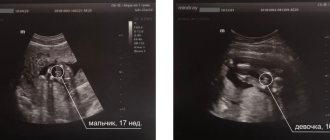Photo: UGC The 25th week of pregnancy brings the expectant mother closer to the end of the seventh month of her cherished term. The baby is actively developing and makes itself felt with kicks and movements. The state of health of a pregnant woman at this stage is usually quite good, and she is pleased with her significantly rounded tummy.
Attention! The material is for informational purposes only. You should not resort to the treatment methods described herein without first consulting your doctor.
Interesting Facts
| Options | Indications |
| Time from conception | 23 weeks |
| Period by month | 25 weeks |
| What month | 6 |
| Dimensions and weight of the fetus | 330 mm, 660 g |
| Uterus dimensions | 1-2 cm above the navel, VDM 22-25 cm |
| Pregnant weight | Gain from the beginning of pregnancy is 5-8 kg; over the last week no more than 400-500 g |
Your baby is the size of
A small pumpkin
330mm Size
660 g Weight
The size of the uterus at 25 weeks of pregnancy is comparable to a football. You begin to walk like a pregnant woman, and it takes some effort to sit and lie down comfortably. The baby continues to actively gain weight and every day he trains to breathe, swallow and control his movements. What else happens to the mother and unborn child at this stage? Let's find out, but first let's decide on the calculations.
Purpose of ultrasound examination
Ultrasound during this period of pregnancy is prescribed to clarify the date of future birth. Also at 25 weeks, specialists determine the degree of development of fetal systems and organs. The process of ridge formation is subject to mandatory research. By week 25, the baby should have 33 vertebrae visualized on ultrasound. There are about 150 joints and 1,000 ligaments in a child’s body. The sonologist examines the fetal heart very carefully and measures its beats per minute, which at this time is 150.
Fetal growth parameters are also recorded, but during this period of pregnancy they are considered average. Due to the increased size of the baby, ultrasound must be performed in stages.
An ultrasound at 25 weeks is necessary to identify defects in the development of various organs. If abnormalities are detected at this time, effective treatment can be undertaken. If the defects are discovered after the 29th week, then the identified anomaly can only be stated and observed, no treatment can be taken.
The specialist needs to use an ultrasound to determine the degree of maturity of the lung tissue.
Feelings of the expectant mother
The growing uterus and abdomen cause discomfort. Burning sensation and heartburn are frequent companions of a pregnant woman. The urge to urinate increases, congestion, swelling, and varicose veins occur.
Due to increased fatigue or pressure changes, a pregnant woman experiences headaches. After standing or walking for a long time, the lower back inevitably starts to pull. Take care of yourself, be sure to take a break from work. Ideally, you can lie down in the middle of the day for 15-20 minutes.
Emotionally, a pregnant woman at 25 weeks feels serene and comfortable. This is facilitated by both an even hormonal background and a nascent connection with the unborn child. Mom feels when the baby moves. Sometimes you can see the baby’s kicks on the surface of the abdomen. He responds to stroking and your voice. This is an amazing miracle that gives a woman the strength to endure all the hardships of pregnancy.
Principles of proper nutrition
In order for a child to develop and grow properly, he needs nutrients. The lack of even one element can negatively affect the health of the baby. Therefore, a woman’s diet should be varied.
It is important that the menu includes fresh fruits and vegetables, meat or fish, and cereals every day. This will saturate the body with useful microelements and vitamins, and will also make it possible to get rid of many digestive problems, such as constipation and heartburn. If you have difficulty passing stool, you should definitely include boiled beets, prunes, kefir and other products that have a laxative effect in your menu.
You need to eat food in small portions, but often. You can sit down at the table every 2-3 hours, since you cannot fast during pregnancy. However, you should also not lean too heavily on high-calorie foods, since the extra pounds will come very quickly, but getting rid of them will be problematic. Therefore, fatty, fried, smoked, flour, sweet and spicy foods should be restricted.
As you know, iron deficiency anemia is a real scourge of pregnant women. To prevent its development, you must include liver (beef, chicken), buckwheat, oatmeal, legumes, and bran in your menu.
It is equally important to drink enough water. You can replace it with fruit drinks and compotes, but you should be careful with herbal infusions.
What does a baby look like at 25 weeks of pregnancy?
He looks more and more like a newborn: the body proportions are correct, facial features have taken shape, the amount of subcutaneous fat is increasing, but the skin is not as transparent as it was a couple of weeks ago. Tiny capillaries appear, giving it a pinkish tint.
The average weight of the fetus is 660 grams, height is 33 cm. It still has enough space in the uterus to actively move. He taps the walls of the uterus, grabs the umbilical cord and his legs with his hands, turns and somersaults.
The child is already reacting to your mood. Are you irritated or angry? The baby is worried along with you and shows this with active movements.
How internal organs develop
- The structure of the brain becomes more complex: auxiliary cells of nervous tissue appear; synapses are formed - nerve connections; the grooves separating the hemispheres become deeper.
- The lungs produce surfactant, which ensures that the alveoli open during the baby's first breath after birth.
Tests and ultrasound
No special studies are carried out during this period, only if there are special indications. Normally, a pregnant woman comes for examination twice a month, having passed a general urine test the day before. The gynecologist notes on the chart the weight, abdominal circumference, and where the fundus of the uterus is located relative to the navel. Measures blood pressure and gives general recommendations to prevent complications.
An ultrasound examination is not prescribed as part of standard pregnancy management at week 25. But if the doctor has doubts about the condition of the fetus, additional examination is carried out. During it, the specialist evaluates the amount of amniotic fluid, the thickness and location of the placenta, the size of the fetus and its heartbeat.
What happens to the uterus of a pregnant woman at this time?
At this stage, the size of the uterus resembles a soccer ball. Its bottom is 25-27 cm above the pubic bone. If deviations from this norm are detected, the pregnant woman is sent for examination. If the fundus is insufficient, placental insufficiency or fetal growth retardation may occur. In some cases, a woman feels contractions of the uterus, which thus prepares for childbirth. But if these contractions are accompanied by severe pain, you need to call an ambulance.
Possible complications
The twenty-fifth week of pregnancy usually passes relatively calmly and serenely from the point of view of the mother's health. But it is important to know the alarming symptoms of pathologies in order to consult a specialist in time.
Early cervical dilatation
It manifests itself as bloody vaginal discharge and severe pain in the lower third of the abdomen and perineum. If detected early, it can be successfully treated with sutures or a pessary.
Gestosis in the second trimester of pregnancy
Accompanied by severe swelling and increased blood pressure. Emergency hospitalization and symptomatic treatment are required.
Polyhydramnios
This diagnosis is made on the basis of ultrasound, which assesses the amount of amniotic fluid. The following signs indirectly indicate the disease:
- difficulty breathing, a woman may literally not have enough air;
- weakness and fatigue even from minor exertion;
- a feeling as if the stomach is turning to stone and rough stretch marks of the skin on it;
- swelling.
This is a dangerous condition for both mother and fetus. In 30% of cases, without medical assistance it leads to the death of the child. Fortunately, serious acute polyhydramnios is extremely rare, while moderate polyhydramnios – on the border of the physiological norm – occurs in every 10 patients and can be successfully treated.
Mother. Changes in the body's condition at 25 weeks

Condition of the mother at the 25th week of pregnancy
Most women at the 25th week of pregnancy feel satisfactorily and are happily awaiting a miracle. Gentle or persistent movements of the fetus daily remind the pregnant woman of the presence of new life in her belly. Sometimes by the 25th week a woman notices an improvement in her appearance (the condition of her skin, hair, nails), but some may be upset if the situation is the opposite.
Why do some women thrive while others have to put up with oily skin and hair?
The answer to this question lies in the hormonal changes that occur in a pregnant woman's body. The appearance of the expectant mother largely depends on the balance of hormones. Many factors influence hormonal balance: from the external environment and nutrition to the age and health status of the pregnant woman. For one woman, two different pregnancies can be completely different, because the initial conditions are always different.
If unpleasant cosmetic features occur (mask of pregnancy, greasiness of hair and skin, fragility of nails and hair), the best option is to consult a gynecologist. Sometimes simple ways to combat “ugly” manifestations (special masks, creams) are sufficient, but in some cases, behind cosmetic problems there are health problems or lack of nutrients. It’s good if a specialist finds the cause and offers suitable treatment.
Cosmetic issues at the 25th week can significantly spoil the mood of a pregnant woman, but they are not the only possible reasons for the disorder. When visiting a gynecologist, many expectant mothers complain of discomfort and symptoms:
- swelling and weight gain for no apparent reason. Edema is the most common pathological process during pregnancy. They can be invisible and practically imperceptible, but if the situation worsens, they can cause a lot of trouble and discomfort. The cause of edema is the accumulation of excess fluid in the body. The kidneys fail to cope with their task; they do not have time to remove all unnecessary fluid from the body, and as a result, it accumulates in the face, arms and legs.
The appearance of edema in the 25th week of pregnancy is a signal to visit a gynecologist. Quite often, this symptom is a harbinger of late toxicosis. With timely correction of nutrition and, possibly, treatment, it is possible to avoid or reduce the consequences of pathological processes in late pregnancy.
- surges in blood pressure. An increase in the amount of blood during pregnancy often leads to periodic surges in blood pressure. In the 25th week, both a fall and an increase in the main indicators are possible. As a result, the woman feels weak, dizzy, headache, drowsiness and, in some cases, nausea. An increase or decrease in blood pressure by more than 30 points from work values requires special attention. Normally (in the absence of hypotension and hypertension), a woman should have blood pressure in the range of 110/70 - 130/90.
The appearance of this symptom is a reason to consult a gynecologist for advice. Jumps in blood pressure must be stopped in order to reduce the likelihood of developing late toxicosis and to avoid complications caused by this process.
- anemia: dizziness, rapid heartbeat, pallor, sleep disturbance (daytime sleepiness, nighttime insomnia), fainting, shortness of breath, dizziness, tinnitus. In some cases, anemia is discovered by a gynecologist by assessing a woman's test results. Anemia during pregnancy is considered to be a blood hemoglobin level below 110 g/l. If this complication is detected, it is necessary to urgently take measures to increase the amount of hemoglobin. If left untreated, complications may develop: premature birth, placental abruption, gestosis, etc.
When anemia is detected, first of all it is necessary to make adjustments to the diet, ensuring sufficient intake of iron, B vitamins and vitamin C into the mother’s body. If the effect of the intervention is insufficient, it is possible to prescribe medications and additional studies aimed at identifying the causes of anemia.
- dyspepsia: heartburn, heaviness in the stomach, flatulence, constipation . The increased size of the uterus (now it is almost like a football) puts pressure on all the organs surrounding it. The gastrointestinal tract is especially difficult. It is unlikely that it will be possible to completely avoid the appearance of symptoms of dyspepsia, but it is possible to create conditions for reducing the intensity: eating 5-6 times a day in small portions;
- the diet contains a lot of vegetables and fruits;
- compliance with the drinking regime (at least 1 liter of clean water per day);
- the presence in the diet of foods that help ease bowel movements (dried apricots, prunes);
- absence of harmful foods in the diet.
The issue of bowel movement requires special attention from a woman. If constipation occurs, you should consult a gynecologist and avoid delaying bowel movements for more than 2 days. Excessive pressure from accumulated feces can negatively affect the pelvic floor muscles and lead to the onset of labor or other complications.
In addition to these symptoms, the following can spoil your mood:
- frequent urination;
- increased skin pigmentation;
- stretch marks.
These unpleasant pregnancy companions are present in most pregnant women, but there are ways to combat them:
- You can reduce the number of trips to the toilet by training your pelvic floor muscles with Kegel exercises. A gynecologist can tell you in detail how to perform them correctly. Also, before urinating, you can lean forward, increasing pressure on the bladder, which will allow you to get rid of more fluid;
- To prevent increased skin pigmentation, it is recommended to avoid direct sunlight. In the summer, a wide-brimmed hat is ideal, hiding the delicate skin of the face from the scorching sun;
- from the 25th week of pregnancy, a woman needs to pay special attention to the skin of her abdomen to avoid the appearance of stretch marks (stretch marks). From this week, the belly will increase very quickly, adding up to 1 cm in volume per week. It is great if the pregnant woman consults a gynecologist about a suitable cream for stretch marks. If it is not possible to buy cream, you can use olive oil to rub into the skin of the abdomen in the evenings.
Movements
At the 25th week of pregnancy, a woman feels increased fetal kicks. They may have different characters. Very soon, the expectant mother will begin to distinguish by the baby’s movements whether he likes food or not, and how he is located in the uterus. There can be a lot of options for sensations: from light gentle to persistent and painful. A pregnant woman should be prepared for the fact that with each subsequent week the force of the baby’s blow will increase and she may have to endure more than one “bright” solo performance of her legs on the stomach, sciatic nerve, and lungs.
Tips for choosing a bandage
A device for supporting an enlarged belly will reduce the load on the spine. This is especially important if the pregnancy is multiple, there is a scar on the uterus, as well as if the cervix is underdeveloped and there is a threat of miscarriage. Even if you are not in the risk group, but spend a lot of time on your feet, the bandage will reduce the feeling of fatigue and reduce discomfort in the lower back.
There are 3 types of bandages: in the form of panties, a corset and a belt. We recommend that you pay attention to the last one - an elastic belt that you can use during pregnancy and after childbirth, simply turning it over to the other side.
When choosing a size, focus on your hip circumference, but make allowances for the fact that it may increase a little more before the end of pregnancy. The most convenient way is to try on the bandage before purchasing, wrapping it under your stomach. However, remember that it is correct to put on the belt only in a lying position.
Checklist for 25 weeks of pregnancy
- To help yourself with insomnia, take a walk before bed, drink tea with mint or motherwort. Lie on your left side with a pillow between your knees.
- Monitor your weight gain: normally, you can gain up to 500 grams weekly. Larger numbers and sharp changes are an alarming sign that requires consultation with a specialist.
- Discuss with your employer the details of your maternity leave: there are only 5 weeks left until it, and if you have a multiple pregnancy, then 3.
Entrust your pregnancy management to the specialists of the Medical Women's Center. We offer you various types of laboratory tests and ultrasound, the ability to choose a doctor and involve other specialists according to indications, an individual observation plan and assistance in selecting a maternity hospital.










